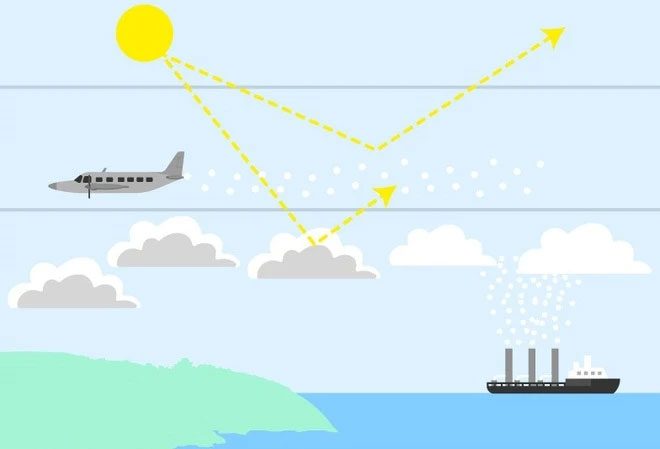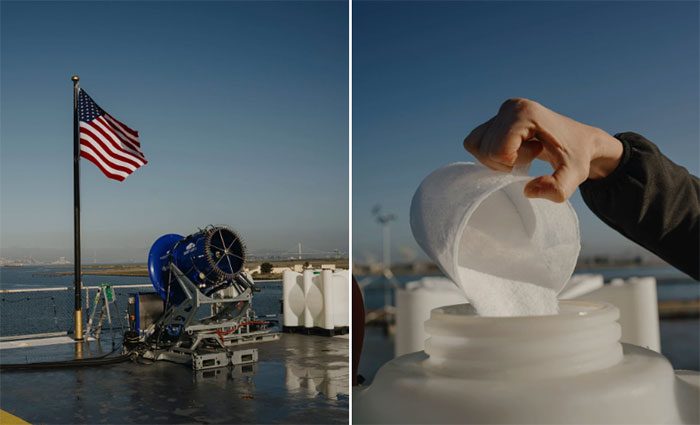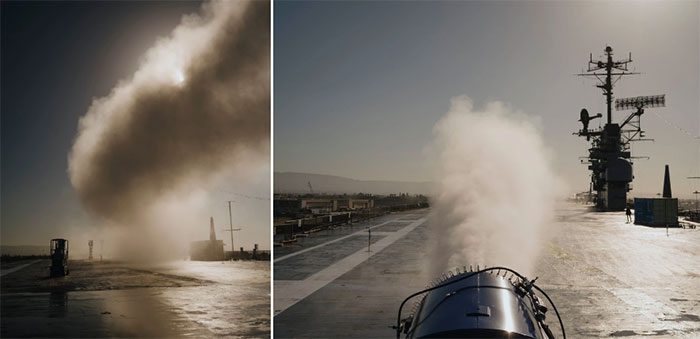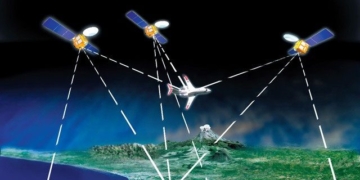A research team in the United States has recently tested cloud brightening technology using seawater. This experiment marks the beginning of a promising technology aimed at mitigating global warming.
At 9 AM, engineer Matthew Gallelli began working on the deck of a decommissioned aircraft carrier in San Francisco Bay, wearing ear protection and flipping a switch.
Seconds later, a device resembling a snow machine began to roar, followed by a loud hissing sound. A fine mist filled with tiny salt particles sprayed everywhere, with these particles capable of traveling dozens of meters into the air.
This is the first outdoor test in the United States for cloud brightening technology. This method makes clouds brighter, reflecting solar radiation back into space more effectively, thereby helping to cool the Earth and combat global warming, according to the New York Times.
Scientists at the University of Washington want to see if this machine, which took years to develop, can spray ultra-small salt particles into the atmosphere outside of a laboratory setting. If successful, the next phase will aim at the skies, attempting to alter the composition of clouds hovering over the oceans.
Originating from a Crazy Idea
Cloud brightening (also known as radiation management or solar geoengineering) is one of many ideas aimed at reflecting solar energy back into space. Compared to other options like injecting gases into the stratosphere, the technique of brightening clouds over the oceans is localized and uses relatively benign seawater aerosols instead of other chemicals.
The concept for this technology originated when British physicist John Latham published a study in the journal Nature titled “Can We Control Global Warming?” in 1990. In the study, he proposed the idea of injecting tiny particles into clouds to potentially reduce rising temperatures.

Similar to aircraft, ships would inject salt aerosols into the atmosphere to brighten clouds, reflecting sunlight back into space. (Photo: Telegraph).
Then, during an afternoon walk with his son, Dr. Latham found further inspiration for this idea. “My son asked why clouds are bright on top but dark underneath. I explained that they are mirrors reflecting sunlight down,” he recalled.
Later, the scientist proposed a wild idea: to create an army of 1,000 unmanned sailboats traversing the world’s oceans, continuously spraying tiny droplets of seawater into the atmosphere to deflect solar radiation away from the Earth.
As the ships moved across the ocean, their emissions could brighten the clouds, creating a “ship wake effect” behind them. In fact, the technique of brightening marine clouds through ship emissions has compensated for about 5% of global warming caused by greenhouse gases, according to Dr. Doherty, an atmospheric scientist at the University of Washington and manager of the marine cloud brightening program.
Ironically, as technology has improved and environmental regulations have reduced pollution from ships, the brightness of the clouds is fading, leading to a rise in temperatures. According to Dr. Doherty, instead of using pollutants, their marine cloud brightening program can be implemented using seawater.
Aambitious Project Supported by Bill Gates
In reality, cloud brightening is not an easy task. Scientist Jessica Medrado, part of the cloud brightening program at the University of Washington, stated that for success, they need to achieve the precise size of the aerosols.
Particles that are too small will be ineffective. If too large, they could have the opposite effect, causing the clouds to reflect less light than before. The ideal size is super-microscopic particles about 1/700th the thickness of a human hair.
Next, scientists need to inject a vast number of those precisely-sized aerosols into the air: one million trillion particles per second. “You can’t find any available tool to do that,” Dr. Medrado said.
The answer to that problem came from billionaire Bill Gates.
In 2006, the Microsoft founder heard the idea of attempting to reflect the sun from David Keith, one of the leading researchers in solar geoengineering. Gates began funding Dr. Keith and Ken Caldeira, another climate scientist and former software developer, to continue their research.

The salt crystals sprayed into the air are microscopic, about 1/700th the thickness of a human hair. (Photo: New York Times).
Then the two scientists met Armand Neukermans, an engineer in Silicon Valley with a PhD in applied physics from Stanford and 74 patents. He invented the system for producing and spraying ink particles for photocopiers. Dr. Caldeira asked whether he could create a nozzle that sprays seawater instead of ink.
Intrigued by the idea, Dr. Neukermans gathered some former colleagues to conduct research in a rented laboratory in 2009, with $300,000 invested by Bill Gates.
The team studied the issue for years, ultimately coming up with a solution. By pushing air at extremely high pressure through a series of nozzles, they could generate enough force to break the salt crystals into ultra-small particles.
By the end of last year, the salt sprayer was assembled and resting in a warehouse near San Francisco. The machinery was ready, and now the research team just needed a place to test it.
The Next Goal is to Head Out to the Open Sea
Ultimately, the USS Hornet, a historic World War II relic recognized by the nation, became the site of the first experiment. The deck is over 15 meters above the shoreline of Alameda, San Francisco Bay. On the morning of April 3, the ship was filled with finely calibrated sensors, sitting atop a scissor lift reaching skyward.
Underneath the American flag was the salt sprayer. It was shiny blue, nearly the shape and size of a stage light, with a steel nozzle surrounding a mouth 1 meter wide. The researchers named it CARI (Cloud Aerosol Research Instrument).

The lift serves to hold sensors to measure the amount of salt sprayed from the machine during the experiment. (Photo: New York Times).
One side of the sprayer consists of a box containing a pair of compressors, which supply high-pressure air to the sprayer through a thick black hose. On the other side is a water tank. A series of switches will be activated in sequence, then water and air will be fed into the device and a fine mist will be sprayed towards the sensors.
The goal is to determine whether the aerosols exiting the sprayer can maintain their size as they travel through the air under varying wind and humidity conditions. According to the New York Times, scientists will take several months to analyze the results. But the answers will help determine whether ocean cloud brightening technology is effective, said Dr. Robert Wood, the lead scientist of the marine research team at the University of Washington.
She believes scientists may need another decade of testing before officially using cloud brightening technology on a large scale to cool the Earth. “The next step is to head out to the ocean, aiming the sprayer a little higher and just touch the clouds,” the doctor told the New York Times.


















































